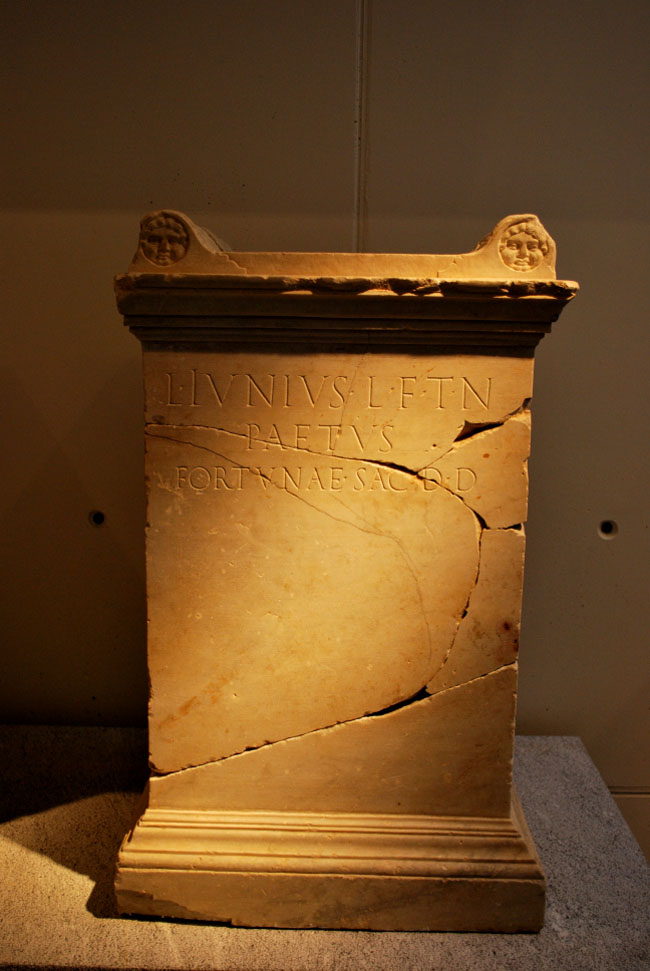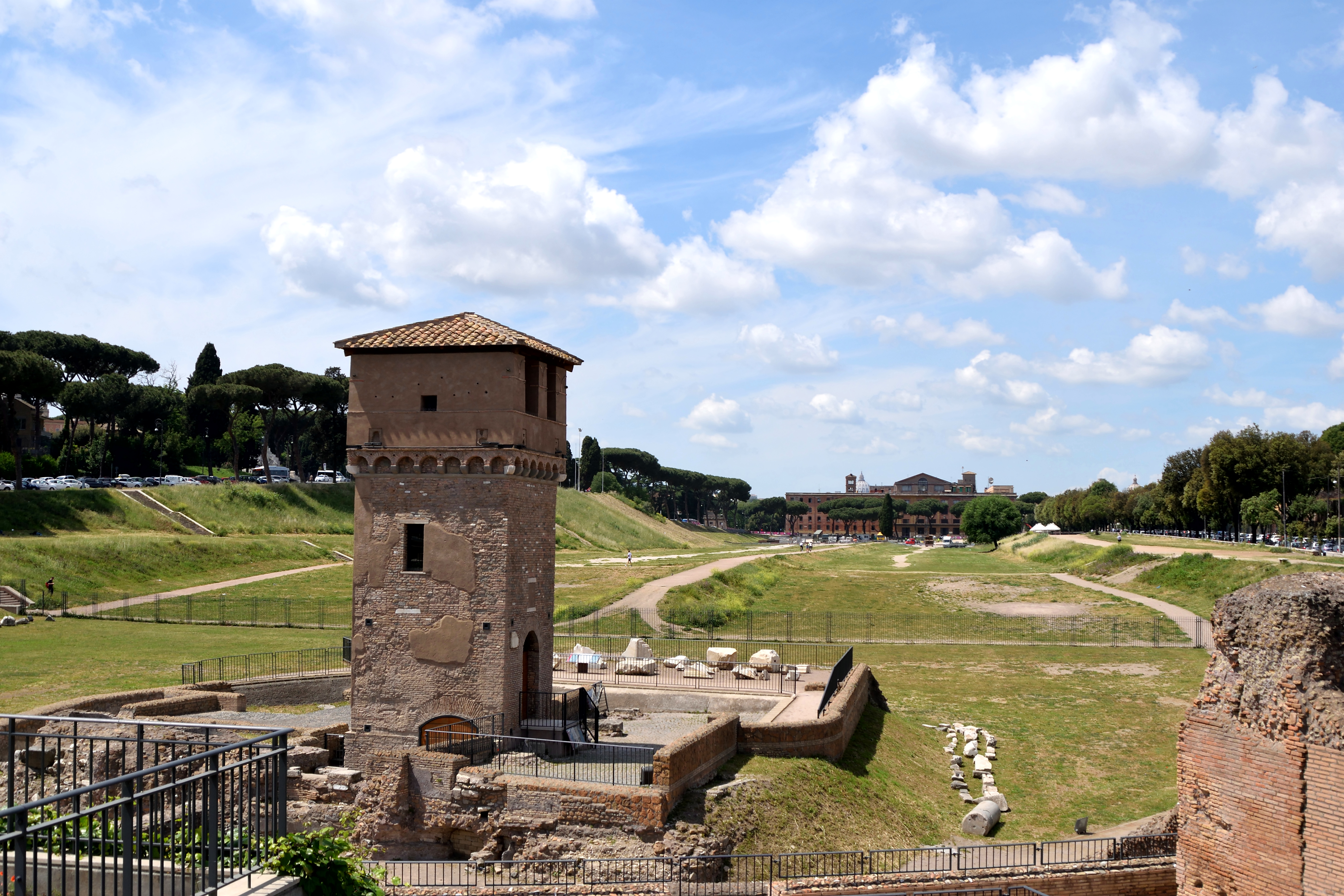|
Temple Of Hercules Victor
The Temple of Hercules Victor ('Hercules the Winner') ( it, Tempio di Ercole Vincitore) or Hercules Olivarius ((Hercules the Olive Branch Bearear) is a Roman temple in Piazza Bocca della Verità in the area of the Forum Boarium near the Tiber in Rome. It is a tholos, a round temple of Greek ' peripteral' design completely surrounded by a colonnade. This layout caused it to be mistaken for a temple of Vesta until it was correctly identified by Napoleon's Prefect of Rome, Camille de Tournon. Despite (or perhaps due to) the Forum Boarium's role as the cattle-market for ancient Rome, the Temple of Hercules is the subject of a folk belief claiming that neither flies nor dogs will enter the holy place. The temple is the earliest surviving marble building in Rome. The Hercules Temple of Victor is also the only surviving sacred temple in ancient Rome that is made of Greek marble. Today it remains unsolved who this temple was dedicated to and for what purpose. Description Dating from th ... [...More Info...] [...Related Items...] OR: [Wikipedia] [Google] [Baidu] |
Forum Boarium
The Forum Boarium (, it, Foro Boario) was the cattle ''forum venalium'' of ancient Rome. It was located on a level piece of land near the Tiber between the Capitoline, the Palatine and Aventine hills. As the site of the original docks of Rome (''Portus Tiberinus''), the Forum Boarium experienced intense commercial activity. The Forum Boarium was the site of the first gladiatorial contest at Rome which took place in 264 BC as part of aristocratic funerary ritual—a '' munus'' or funeral gift for the dead. Marcus and Decimus Junius Brutus Scaeva put on a gladiatorial combat in honor of their deceased father with three pairs of gladiators. The site was also a religious centre housing the Temple of Hercules Victor, the Temple of Portunus (Temple of Fortuna Virilis), and the massive 6th or 5th century BC Great Altar of Hercules. Architecture The Temple of Hercules Victor or ''Hercules Olivarius'' (Hercules the Olive Branch Bearear ), is a circular peristyle buildi ... [...More Info...] [...Related Items...] OR: [Wikipedia] [Google] [Baidu] |
Architrave
In classical architecture, an architrave (; from it, architrave "chief beam", also called an epistyle; from Greek ἐπίστυλον ''epistylon'' "door frame") is the lintel or beam that rests on the capitals of columns. The term can also apply to all sides, including the vertical members, of a frame with mouldings around a door or window. The word "architrave" has come to be used to refer more generally to a style of mouldings (or other elements) framing a door, window or other rectangular opening, where the horizontal "head" casing extends across the tops of the vertical side casings where the elements join (forming a butt joint, as opposed to a miter joint). Classical architecture In an entablature in classical architecture, it is the lowest part, below the frieze and cornice. The word is derived from the Greek and Latin words ''arche'' and ''trabs'' combined to mean "main beam". The architrave is different in the different Classical orders. In the Tuscan ... [...More Info...] [...Related Items...] OR: [Wikipedia] [Google] [Baidu] |
Christianised Sites
The Christianization of sites that had been pagan occurred as a result of conversions in early Christian times, as well as an important part of the strategy of ''Interpretatio Christiana'' ("Christian reinterpretation") during the Christianization of pagan peoples. The landscape itself was Christianized, as prominent features were rededicated to Christian saints, sometimes quite directly, as when the island of Oglasa in the Tyrrhenian Sea was christened Montecristo. Early Christianity In the first centuries of Christianity churches were either house churches in whatever houses were offered for use by their owners, or were shrines on the burial-sites of martyrs or saints, which following the usual classical practice were invariably on the (then) edges of cities - the necropolis was always outside the ''polis''. In Rome the early basilica churches of St. Peter's, Saint Paul Outside the Walls and San Lorenzo fuori le Mura, all follow this pattern. This distinction was graduall ... [...More Info...] [...Related Items...] OR: [Wikipedia] [Google] [Baidu] |
World History Encyclopedia
World History Encyclopedia (formerly Ancient History Encyclopedia) is a nonprofit educational company created in 2009 by Jan van der Crabben. The organization publishes and maintains articles, images, videos, podcasts, and interactive educational tools related to history. All users may contribute content to the site, although submissions are reviewed by an editorial team before publication. In 2021, the organization was renamed from the Ancient History Encyclopedia to World History Encyclopedia to reflect its broadened scope, covering world history from all time periods, as opposed to just ancient history. Original articles are written in English and later translated into other languages, mainly French and Spanish. Organization history The Ancient History Encyclopedia was founded in 2009 by van der Crabben with the stated goal of improving history education worldwide by creating a freely accessible and reliable history source. The nonprofit organization is based in Godalming, Uni ... [...More Info...] [...Related Items...] OR: [Wikipedia] [Google] [Baidu] |
Temple Hercule Olivarius - Plan
A temple (from the Latin ) is a building reserved for spiritual rituals and activities such as prayer and sacrifice. Religions which erect temples include Christianity (whose temples are typically called churches), Hinduism (whose temples are called Mandir), Buddhism, Sikhism (whose temples are called gurudwara), Jainism (whose temples are sometimes called derasar), Islam (whose temples are called mosques), Judaism (whose temples are called synagogues), Zoroastrianism (whose temples are sometimes called Agiary), the Baha'i Faith (which are often simply referred to as Baha'i House of Worship), Taoism (which are sometimes called Daoguan), Shinto (which are sometimes called Jinja), Confucianism (which are sometimes called the Temple of Confucius), and ancient religions such as the Ancient Egyptian religion and the Ancient Greek religion. The form and function of temples are thus very variable, though they are often considered by believers to be, in some sense, the "house ... [...More Info...] [...Related Items...] OR: [Wikipedia] [Google] [Baidu] |
Epithet
An epithet (, ), also byname, is a descriptive term (word or phrase) known for accompanying or occurring in place of a name and having entered common usage. It has various shades of meaning when applied to seemingly real or fictitious people, divinities, objects, and binomial nomenclature. It can also be a descriptive title: for example, Pallas Athena, Phoebus Apollo, Alfred the Great, Suleiman the Magnificent, and Władysław I the Elbow-high. Many English monarchs have traditional epithets: some of the best known are Edward the Confessor, William the Conqueror, Richard the Lionheart, Æthelred the Unready, John Lackland and Bloody Mary. The word ''epithet'' can also refer to an abusive, defamatory, or derogatory phrase. This use as a euphemism is criticized by Martin Manser and other proponents of linguistic prescription. H. W. Fowler complained that "epithet is suffering a vulgarization that is giving it an abusive imputation." Linguistics Epithets are somet ... [...More Info...] [...Related Items...] OR: [Wikipedia] [Google] [Baidu] |
Roman Calendar
The Roman calendar was the calendar used by the Roman Kingdom and Roman Republic. The term often includes the Julian calendar established by the reforms of the Roman dictator, dictator Julius Caesar and Roman emperor, emperor Augustus in the late 1stcenturyBC and sometimes includes any system dated by inclusive counting towards months' kalends, nones (calendar), nones, and ides (calendar), ides in the Roman manner. The term usually excludes the Alexandrian calendar of Roman Egypt, which continued the unique months of that land's Egyptian calendar, former calendar; the Byzantine calendar of the Byzantine Empire, later Roman Empire, which usually dated the Roman months in the simple count of the ancient Greek calendars; and the Gregorian calendar, which refined the Julian system to bring it into still closer alignment with the tropical year. Roman dates were counted inclusively forward to the next of three principal days: the first of the month (the kalends), a day shortly befor ... [...More Info...] [...Related Items...] OR: [Wikipedia] [Google] [Baidu] |
Glossary Of Ancient Roman Religion
The vocabulary of ancient Roman religion was highly specialized. Its study affords important information about the religion, traditions and beliefs of the ancient Romans. This legacy is conspicuous in European cultural history in its influence on later juridical and religious vocabulary in Europe, particularly of the Western Church. This glossary provides explanations of concepts as they were expressed in Latin pertaining to religious practices and beliefs, with links to articles on major topics such as priesthoods, forms of divination, and rituals. For theonyms, or the names and epithets of gods, see List of Roman deities. For public religious holidays, see Roman festivals. For temples see the List of Ancient Roman temples. Individual landmarks of religious topography in ancient Rome are not included in this list; see Roman temple. __NOTOC__ Glossary A abominari The verb ''abominari'' ("to avert an omen", from ''ab-'', "away, off," and ''ominari'', "to pronounce on ... [...More Info...] [...Related Items...] OR: [Wikipedia] [Google] [Baidu] |
Circus Maximus
The Circus Maximus ( Latin for "largest circus"; Italian: ''Circo Massimo'') is an ancient Roman chariot-racing stadium and mass entertainment venue in Rome, Italy. In the valley between the Aventine and Palatine hills, it was the first and largest stadium in ancient Rome and its later Empire. It measured in length and in width and could accommodate over 150,000 spectators. In its fully developed form, it became the model for circuses throughout the Roman Empire. The site is now a public park. Events and uses The Circus was Rome's largest venue for '' ludi'', public games connected to Roman religious festivals. ''Ludi'' were sponsored by leading Romans or the Roman state for the benefit of the Roman people (''populus Romanus'') and gods. Most were held annually or at annual intervals on the Roman calendar. Others might be given to fulfil a religious vow, such as the games in celebration of a triumph. In Roman tradition, the earliest triumphal ''ludi'' at the ... [...More Info...] [...Related Items...] OR: [Wikipedia] [Google] [Baidu] |
Macrobius
Macrobius Ambrosius Theodosius, usually referred to as Macrobius (fl. AD 400), was a Roman provincial who lived during the early fifth century, during late antiquity, the period of time corresponding to the Later Roman Empire, and when Latin was as widespread as Greek among the elite. He is primarily known for his writings, which include the widely copied and read '' Commentarii in Somnium Scipionis'' ("Commentary on the Dream of Scipio") about ''Somnium Scipionis'', which was one of the most important sources for Neoplatonism in the Latin West during the Middle Ages; the ''Saturnalia'', a compendium of ancient Roman religious and antiquarian lore; and ''De differentiis et societatibus graeci latinique verbi'' ("On the Differences and Similarities of the Greek and Latin Verb"), which is now lost. He is the basis for the protagonist Manlius in Iain Pears' book '' The Dream of Scipio''. Name The correct order of his names is "Macrobius Ambrosius Theodosius", which is how it ap ... [...More Info...] [...Related Items...] OR: [Wikipedia] [Google] [Baidu] |
Aeneid
The ''Aeneid'' ( ; la, Aenē̆is or ) is a Latin Epic poetry, epic poem, written by Virgil between 29 and 19 BC, that tells the legendary story of Aeneas, a Troy, Trojan who fled the Trojan_War#Sack_of_Troy, fall of Troy and travelled to Italy, where he became the ancestor of the Ancient Rome, Romans. It comprises 9,896 lines in dactylic hexameter. The first six of the poem's twelve books tell the story of Aeneas' wanderings from Troy to Italy, and the poem's second half tells of the Trojans' ultimately victorious war upon the Latins (Italic tribe), Latins, under whose name Aeneas and his Trojan followers are destined to be subsumed. The hero Aeneas was already known to Greco-Roman legend and myth, having been a character in the ''Iliad''. Virgil took the disconnected tales of Aeneas' wanderings, his vague association with the foundation of Ancient Rome, Rome and his description as a personage of no fixed characteristics other than a scrupulous ''pietas'', and fashioned th ... [...More Info...] [...Related Items...] OR: [Wikipedia] [Google] [Baidu] |
Maurus Servius Honoratus
Servius was a late fourth-century and early fifth-century grammarian. He earned a contemporary reputation as the most learned man of his generation in Italy; he authored a set of commentaries on the works of Virgil. These works, ''In tria Virgilii Opera Expositio'', constituted the first incunable to be printed at Florence, by Bernardo Cennini, in 1471. In the ''Saturnalia'' of Macrobius, Servius appears as one of the interlocutors; allusions in that work and a letter from Symmachus to Servius indicate that he was not a convert to Christianity. Commentary on Virgil The commentary on Virgil ( la, In Vergilii Aeneidem commentarii) survives in two distinct manuscript traditions. The first is a comparatively short commentary, attributed to Servius in the superscription in the manuscripts and by other internal evidence. The second class derive from the 10th and 11th centuries, embed the same text in a much expanded commentary. The copious additions are in contrasting style to ... [...More Info...] [...Related Items...] OR: [Wikipedia] [Google] [Baidu] |
.jpg)






